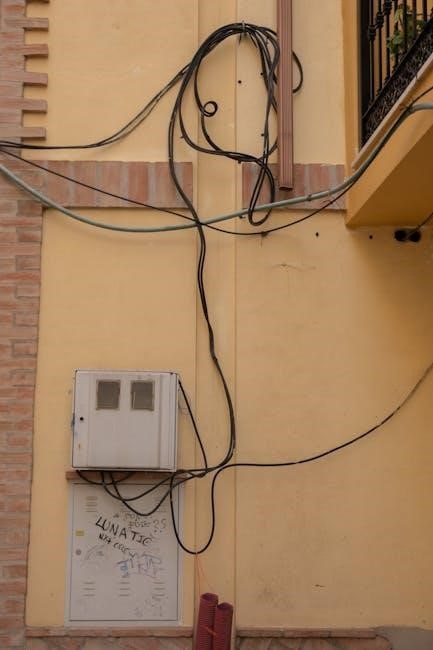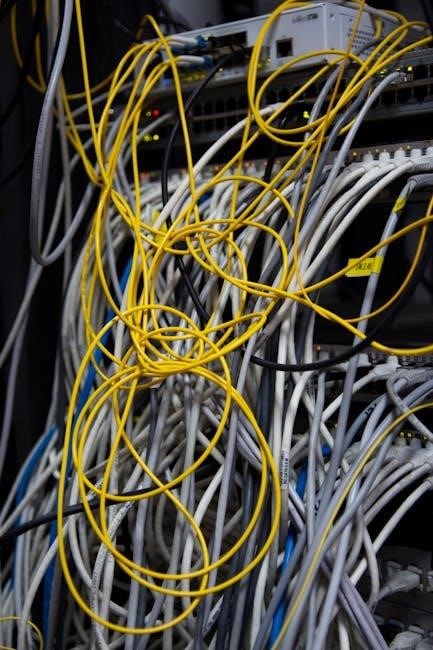3-way switch wiring diagrams provide essential visual guides for controlling lights from multiple locations. These diagrams simplify complex connections, ensuring safe and successful installations for DIY enthusiasts and professionals alike.
Understanding the Basics of 3-Way Switches
A 3-way switch allows control of a light fixture from two different locations. It features three terminals: a common terminal and two traveler terminals. The common terminal connects to the power source or the light, while the traveler terminals connect to the other switch. Unlike a standard switch, a 3-way switch does not have an “on/off” position but works in tandem with another 3-way switch to control the light. This setup requires a 3-wire cable between the switches, enabling the light to be activated from either location. Wiring diagrams are essential for proper installation.
Importance of Using Wiring Diagrams for 3-Way Switches
Wiring diagrams are crucial for safely and correctly installing 3-way switches. They provide a clear visual representation of connections, reducing errors and ensuring compliance with electrical standards. Diagrams help identify line, load, and traveler wires, simplifying the process. By following a diagram, you avoid dangerous short circuits and ensure the system functions properly. They also save time and reduce frustration during installation. Whether you’re a DIY enthusiast or a professional, a wiring diagram is an indispensable tool for successful 3-way switch projects.

Components and Tools Required
Essential components include 3-way switches, wire connectors, and cables. Tools like wire strippers, voltage testers, and screwdrivers are necessary for safe and efficient installation.
Identifying Line, Load, and Traveler Wires
Line wires carry power from the circuit breaker to the switch. Load wires connect the switch to the light fixture. Traveler wires link the switches, enabling dual control. The common terminal on a 3-way switch is usually connected to the line or load wire. Traveler wires are connected to the brass terminals. Correct identification ensures proper wiring and safe operation. Using a voltage tester can help verify live wires before starting work. Accurate wire identification is crucial for successful 3-way switch installation and functionality.
Tools Needed for 3-Way Switch Installation
Essential tools for 3-way switch installation include wire strippers, needle-nose pliers, and screwdrivers. A voltage tester ensures safety by identifying live wires. A drill and fish tape are necessary for running wires through walls. Utility knives are handy for cutting wire insulation. Picking the right tools ensures precise connections and avoids damage. Proper organization of tools prevents delays and ensures a smooth installation process. Always use high-quality tools for reliability and safety during electrical work.

Step-by-Step Wiring Process
Connect the live wire to the common terminal of the first switch. Use traveler wires to link brass terminals between switches. Ensure all connections are secure and grounded properly.
Connecting the Common Terminal
Connect the live wire to the common terminal on one 3-way switch. This terminal is typically the black screw. Secure the wire firmly to ensure a safe connection. Proceed to link the traveler wires between both switches’ brass terminals, enabling control of the light fixture from two locations. Always turn off power at the circuit breaker before starting work to prevent electrical hazards.
Wiring the Traveler Terminals
Next, connect the traveler wires between the two 3-way switches. Use the black and red wires to link the brass terminals on each switch. This creates a path for the electrical current to flow through both switches. Ensure the connections are secure to maintain proper function. After wiring the traveler terminals, connect the remaining wires to the light fixture, completing the circuit. Always follow the wiring diagram for accuracy and safety during the installation process.
Downloadable PDF Guide
A downloadable PDF guide provides detailed 3-way switch wiring diagrams, step-by-step instructions, and troubleshooting tips. It’s a valuable resource for DIYers and professionals, ensuring accurate installations.
Accessing Detailed Wiring Diagrams in PDF Format
Accessing detailed wiring diagrams in PDF format is straightforward, offering clear visual representations of 3-way switch connections. These diagrams are comprehensive, covering various configurations, such as power at the switch, light between switches, and integrating 4-way switches. They include step-by-step instructions, wire color coding, and troubleshooting tips. The PDF guides are downloadable and printable, making them ideal for DIY projects and professional installations. They ensure accurate and safe wiring practices, helping users master complex setups with ease and confidence.
Downloading and Printing the 3-Way Switch Wiring Diagram
Downloading and printing the 3-way switch wiring diagram ensures you have a clear, offline reference for your project. PDF guides offer high-resolution schematics, making it easy to follow each connection step. Print the diagrams on standard paper for handy use during installation. Ensure your printer settings maintain the original scaling to preserve wire color codes and terminal labels. Having a physical copy helps prevent errors and streamlines the wiring process, whether you’re a novice or experienced electrician.

Safety Precautions and Best Practices
Always turn off power at the circuit breaker before starting work. Use a voltage tester to confirm wires are de-energized. Properly ground wires and avoid overloaded circuits.
Ensuring Safe Electrical Connections
To ensure safe electrical connections, always turn off the main power supply before starting work. Use a voltage tester to confirm wires are de-energized. Properly ground all wires to prevent shocks. Avoid overloaded circuits and use the correct gauge of wire for the application. Secure all connections tightly to prevent loose wires, which can cause arcing or fires. Follow local electrical codes and consult a licensed electrician if unsure. Safety should always be the top priority when working with electrical systems.
Common Mistakes to Avoid in 3-Way Switch Wiring
Common mistakes include misidentifying line, load, and traveler wires, leading to incorrect connections. Forgetting to use a common wire or reversing traveler wires can cause switches to malfunction. Overlooking proper grounding increases safety risks. Incorrectly wiring the switches can result in lights not functioning or creating short circuits. Always follow a wiring diagram and double-check connections before restoring power. Taking shortcuts or ignoring safety precautions can lead to dangerous electrical issues. Careful planning and adherence to best practices minimize errors and ensure reliable operation.
Troubleshooting Common Issues
Identify issues like faulty connections or incorrect wiring by checking light activation and switch functionality. Use diagrams to trace connections and ensure proper wire placement for reliable operation.
Identifying and Fixing Faulty Connections
Faulty connections in 3-way switch wiring often cause lights to malfunction or not turn on. To identify issues, check for loose wires, incorrect terminal connections, and improper wire nuts. Use a voltage tester to verify live wires and ensure the common, traveler, and load wires are correctly connected. If a wire is misplaced, refer to the wiring diagram to correct the connection. Secure all terminals tightly and test the system to confirm proper operation. Fixing faulty connections requires patience and attention to detail to ensure reliable performance.
Resolving Issues with Light Activation
If lights fail to activate, check the wiring connections between switches and the light fixture. Ensure the common, traveler, and load wires are correctly connected. Verify that power is supplied to the circuit and that no breakers are tripped. Consult the wiring diagram to confirm proper configuration. Use a voltage tester to identify any disconnected or faulty wires. Correcting connections and ensuring all terminals are secure typically resolves activation issues, restoring proper light control from both switches.

Advanced Wiring Configurations
Explore integrating 4-way switches for expanded control and wiring multiple lights with 3-way switches for enhanced flexibility and lighting management in larger spaces.
Integrating 4-Way Switches into the System
Integrating 4-way switches enhances control by allowing additional switching points. This setup requires two 3-way switches at each end and 4-way switches in between. Use a 3-wire cable between switches to maintain proper connections. The common terminal on the 3-way switches connects to the traveler terminals on the 4-way switches. This configuration ensures smooth operation of lights from multiple locations, offering increased flexibility for complex lighting setups. Proper wiring diagrams are essential to avoid errors and ensure reliability.
Wiring Multiple Lights with 3-Way Switches
Wiring multiple lights with 3-way switches allows for versatile control from different locations. Connect the common terminal of the first switch to the power source, and the traveler terminals to the second switch. Use 3-wire cables between switches and 2-wire cables to the lights. Ensure each light is connected to the load terminal of the respective switch. Proper wiring diagrams are crucial to maintain consistent power supply and ensure all lights function correctly with the switches. This setup offers flexibility for controlling multiple fixtures efficiently.
Mastering 3-way switch wiring enhances your DIY electrical skills. For further learning, explore detailed PDF guides and tutorials offering step-by-step instructions and troubleshooting tips.
Final Tips for Successful 3-Way Switch Installation
Always refer to a 3-way switch wiring diagram for clarity. Ensure the common terminal is correctly identified and connected. Use a voltage tester to verify live wires. Double-check traveler wire connections between switches. Properly secure all wires under terminals. Consider labeling wires to avoid confusion. Follow safety guidelines to prevent electrical hazards. Practice patience and methodical steps to achieve a reliable setup. Consulting additional resources or seeking professional help is advisable if uncertainty arises.
Recommended Resources for Further Learning
For in-depth understanding, refer to detailed 3-way switch wiring diagrams in PDF guides. Explore books like “Wiring Complete” by Cool Springs Press for comprehensive tutorials. Online platforms such as The Spruce and Family Handyman offer step-by-step instructions and troubleshooting tips. YouTube channels specializing in DIY electrical projects provide visual demonstrations. Additionally, forums like Reddit’s r/electricians can offer expert advice. These resources cover fundamental concepts, advanced configurations, and practical applications, ensuring a thorough mastery of 3-way switch installations and related electrical systems.